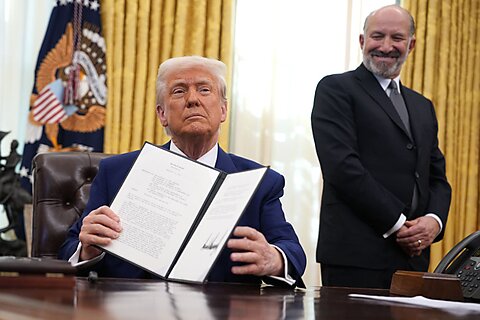Colin Grabow
Earlier this month, President Trump paused his “Liberation Day” tariffs, citing an alleged desire from over 75 (unnamed) countries to launch negotiations on a range of trade-related issues. An optimistic interpretation is that the move confirms Trump’s use of tariffs as a cage-rattling tactic designed to secure improved trade deals. Short-term tariff pain will lead to long-term gains through the lowering and removal of foreign trade barriers.
Such thinking holds that while Trump’s methods may be highly unorthodox, they will ultimately produce a freer trade environment.
Even (generously) assuming this is the ardent protectionist’s goal, however, Trump’s approach is deeply flawed. Whatever is ultimately achieved in terms of reduced tariffs and trade barriers could be more easily obtained through free trade agreements.
To understand why, let’s first take stock of the enormous damage already inflicted. Uncertainty is up and business confidence is down as markets have been whipsawed and intricate supply chains imperiled. And there’s no end in sight. Indeed, additional tariffs might be on the way.
Just getting back to the tariff starting line will be no easy task.
If over 75 countries desire negotiations, that means over 75 negotiations must be concluded. That takes time. Bilateral free trade deals usually require 18 months, and even a US-Japan “mini-deal” covering 5 percent of bilateral trade took six months. Although President Trump claims he could wrap up the deals in a single day, this would almost certainly entail significant compromises on the scope of discussions.
Indeed, Sen. Bill Hagerty (R‑TN) recently said the deals might merely consist of written commitments from foreign governments to make various reforms. Aggressive tariff and trade barrier reductions would be unlikely, providing a meager return on President Trump’s costly approach.
Fortunately, there’s a more effective, expansive, and less disruptive way of securing lowered tariffs and trade barriers. Rather than hurling tariff thunderbolts to get the attention of US trade partners, President Trump should invite them to negotiate free trade agreements (FTAs).
FTAs aren’t new. Indeed, since signing its first such agreement (with Israel) in 1985, the United States has concluded FTAs covering 20 countries. Under such agreements, signatories agree to reduce their tariffs and other trade barriers (see chart) covering substantially all trade with certain limited exceptions. The reductions are reciprocal, and all sides agree on a common set of rules.
The Trans-Pacific Partnership (TPP), an agreement that the United States signed with eleven other countries in 2016 but withdrew from shortly after President Trump took office in 2017, offers a good example. Under the agreement, later implemented without the United States as the Comprehensive and Progressive Trans-Pacific Partnership (CPTPP), 99 percent of tariffs among member countries are eliminated.
Vietnam was among the CPTPP member countries where US goods and services would enjoy substantially improved access had the United States ratified the agreement. Although Hanoi (targeted by the US with 46 percent “reciprocal” tariffs) and the Trump administration may very well end up striking a deal that includes Vietnam’s removal or reduction of some trade barriers, it will almost certainly pale in comparison with what was agreed to under the TPP/CPTTP.
The bilateral US-South Korea Free Trade Agreement (KORUS) offers another example. Entering into force in 2012, the FTA eliminated 98 percent of tariffs over ten years. This included big wins for US exporters, such as South Korea eliminating its 8 percent tariffs on autos and auto parts (equivalent US tariffs were also eliminated from a previous 2.5 percent rate). US consumers and businesses, meanwhile, also benefited from tariff-free access to Korean consumer products and intermediate goods such as machinery.
What deal could the Trump administration realistically strike that would improve on what the KORUS had already achieved?
To be sure, FTAs have their downsides. As such deals require congressional approval, they are subject to the same rent-seeking, special carve-outs, and favor-granting that bedevil all manners of legislation (overzealous intellectual property rights contained in the TPP come to mind). These, of course, should be resisted. Overall, however, (as shown in the Cato Institute’s TPP analysis), the gains produced by such agreements outweigh their pitfalls.
FTAs also typically aren’t quick or easy. Negotiations are often dragged-out affairs (the TPP took eight years to negotiate) that occur well outside the limelight. The pomp and circumstance of a signing ceremony would be some way off. But such drawbacks are small beer compared to the chaos and increasing economic fallout of the administration’s current approach.
All of this assumes, of course, that President Trump is truly interested in a legacy of freer trade and expanded international commerce—a proposition that appears increasingly doubtful. If he wants to prove his doubters wrong, secure truly reciprocal trade barrier reductions, and showcase his savvy at the negotiating table. The FTA path awaits.

